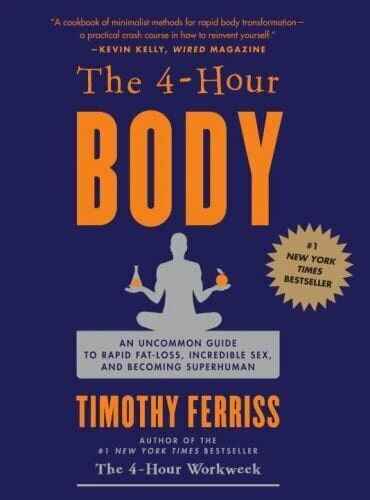The 4-Hour Body: An Uncommon Guide to Rapid Fat-Loss, Incredible Sex, and Becoming Superhuman
Today, I’d like to share a summary and my insights on Timothy Ferriss’ book, “The Four Hour Body: An Uncommon Guide to Rapid Fat Loss, Incredible Sex, and Becoming Superhuman“. Seven years ago, I read Ferriss’ New York Times bestseller, “The Four Hour Work Week“, a book that left a lasting impact on me. After all, even years after reading a book, some ideas manage to stay with you.
From “The Four Hour Work Week”, two concepts have remained vivid in my mind. First is the concept of geo arbitrage – a fusion of geography and arbitrage. It signifies capitalizing on the differences in cost of living across various geographical locations. Examples of geo arbitrage might include digital nomads who work remotely in one place while earning salaries from another, or outsourcing work to locations with lower living costs. Having been involved in the outsourcing field for over two decades, this concept resonated with me. Another aspect of geo arbitrage is retiring to a location with lower living costs.
The second idea that stuck with me is the concept of mini-retirement – an alternative to traditional retirement. Instead of working for decades and then going on a retirement spree at the end of life, Ferriss proposes taking breaks or mini-retirements throughout one’s working life. These can be periods lasting a few months to a year, where one breaks from the routine of work to pursue activities usually associated with traditional retirement, such as traveling, learning new skills, or pursuing a project.
I’ve expanded on this concept, developing a theory of perpetual retirement. According to this theory, one might work intensively until, say, age 40, then enter a perpetual state of retirement. In this state, you pursue all the activities you planned for post-retirement, rather than waiting. It differs from a mini-retirement, which lasts for a specific period, as this state of mind is continuous. The age for transitioning into this perpetual retirement can vary among individuals, but the concept remains the same: once you’ve invested a certain portion of your life in your career, you shift your focus to other aspects of life.
Under this model, you’re working as long as you’re physically and mentally able, but you’re also pursuing the activities you would traditionally save for retirement. This means not compromising any area of your life by overworking or placing too much emphasis on career or wealth. The split could be 50-50 or even 25-75, with a quarter of your productive hours dedicated to work and the majority given to self-care and the activities you’d typically do in retirement.
Living in this perpetual state of retirement for several years now, I’ve found that I’m able to sustain a balance of 25% work and 75% self-care and retirement-related activities. This balance allows you to maintain a working lifestyle indefinitely without it taking a toll on you. It keeps you mentally sharp, socially engaged, and allows for professional progress while preserving a sense of purpose. I’ve seen numerous examples of people who, upon officially retiring, experience a decline in health and sense of purpose. In the perpetual state of retirement, you avoid this decline, maintaining a sense of purpose and well-being. However, this model requires you to enjoy what you’re doing, otherwise, extending your working life may only extend your misery.
Let’s now move on to the summary of the book, “The Four Hour Body.” The book is divided into various sections, starting with subcutaneous fat loss, where Ferriss encourages a slow carb diet. In my experience of reading numerous health books, it’s not always about learning new things. Sometimes it’s about reinforcing previously understood concepts. Being reminded of these concepts can be as beneficial as learning them for the first time, especially if they’ve been forgotten due to disuse.
One of the concepts Ferriss discusses in his slow-carb diet is the elimination of fruits, particularly those with a high glycemic index. Inclusion of legumes is another important point. For instance, I was consuming mangoes, especially during summer, which are high on the glycemic index. Consuming a large mango can introduce more than 50 grams of sugar into your system. Despite the nutritional benefits of mangoes, for the body, this influx of fructose can trigger similar responses as consuming refined sugar, spiking glucose and insulin levels. This book served as a good reminder for me.
Ferriss also recommends consuming legumes with each meal because they slow down digestion, keep you feeling fuller for longer, and help minimize blood sugar spikes. Legumes, including lentils, beans, and peas, offer a sense of fullness as they take longer for the body to digest, and they are a good source of protein.
He also introduces the concept of “cheat days“. We sometimes end up having these cheat days either willingly or unwillingly, where we consume excessive or unhealthy food. Ferriss, however, suggests having one dedicated cheat day each week where you can eat whatever you like. He argues this is actually beneficial for the body because it prevents the body from becoming too accustomed to a particular diet or sugar level, thereby keeping the metabolism active.
I have started to appreciate these cheat days as they offer psychological relief from a strict low-calorie, low-carb diet and can be sustained over the long term. They also give your metabolism a boost and prevent it from slowing down due to a consistent low-calorie intake. Additionally, cheat days can aid in glycogen replenishment. Glycogen, a form of stored glucose, serves as a reserve energy source, and a low-carb diet can deplete glycogen stores. Reintroducing carbs during a cheat day can help replenish these stores, which is particularly beneficial for those engaging in regular physical activity.
Ferriss then discusses muscle building and highlights that doing less can actually be more effective if done correctly. It’s often beneficial to get professional help in this area for guidance and motivation.
He also delves into improving sexual performance and satisfaction, although some readers might find this section a bit graphic. He provides techniques for enhancing sleep quality, mainly by increasing REM sleep and reducing total sleep time. Some of these methods include taking cold showers before bed or limiting exposure to blue light, which can inhibit the release of melatonin.
Ferriss goes on to discuss reversing injuries and improving running speed and endurance. The book concludes with the topics of strength enhancement and longevity. An idea that resonates with me is the importance of quality, not just quantity, of life. If longer life comes with pain and chronic diseases, then the quality of life is compromised.
The book also presents various case studies, many based on Ferriss’s own experiments. Overall, the book served as a good reminder and reinforcement of some ideas, and it introduced some new ones. The effectiveness of any strategy greatly depends on the individual, but my three biggest takeaways were the benefits of consuming legumes in every meal or at least once a day, reducing intake of high glycemic fruit, and the importance of cheat days. I would recommend this book; it’s an enjoyable, casual read.

